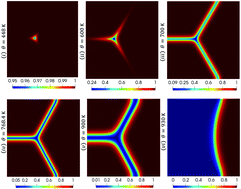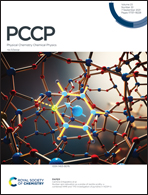Grain boundary-induced premelting and solid ↔ melt phase transformations: effect of interfacial widths and energies and triple junctions at the nanoscale
Abstract
The strong effect of dry grain boundary (GB) and isolated solid–melt interface widths and energies and the triple junction energy on GB-induced premelting and the transformations between solid, premelt, and melt at the nanoscale are studied using a thermodynamically consistent original phase field approach of Ginzburg–Landau type. One order parameter is considered for describing solid ↔ melt transformation and another N − 1 independent order parameters are used to describe N grains in the samples. A variable energy of the GB regions is assumed which depends on the order parameter related to solid ↔ melt transformation, and the energy of the GBs reduces from their dry state energy γgb in solid to zero at melt. The complex ‘phase diagrams’, showing the variation of the transformation temperatures with the non-dimensional width ratio (ratio of dry GB width and isolated solid–melt interface width), are plotted for 2D bicrystals with a planar GB and a circular GB for the cases when (i) solid–melt interface width is fixed and GB width varies, and (ii) GB width is fixed and solid–melt interface width varies. A bistable region, where the premelt spontaneously appears or transforms back to the solid, is shown indicating that these transformations accompany hysteresis. The effect of the width ratio on the effective melt layer thickness and the disjoining potential between the solid–melt interfaces on premelting/melting is also studied. The effect of triple junctions on the transformations is studied in tricrystals having three planar GBs meeting at the interior of the sample with equal dihedral angles. A premelt/melt pocket appears at the junction in a jump-like manner at temperatures significantly lower than the temperatures at which the GBs premelt. The premelt/melt that appeared at the junction eventually wets the adjacent GBs, and finally, the entire sample melts at the melting point. The results show a plausible reason for differences in the premelting and melting temperature ranges of the GBs observed in various experimental and atomistic studies.



 Please wait while we load your content...
Please wait while we load your content...